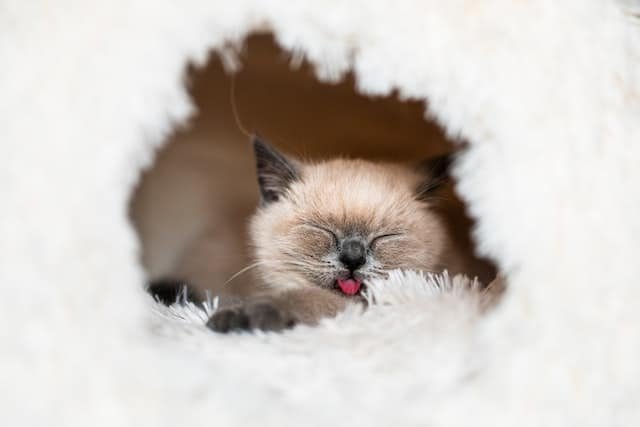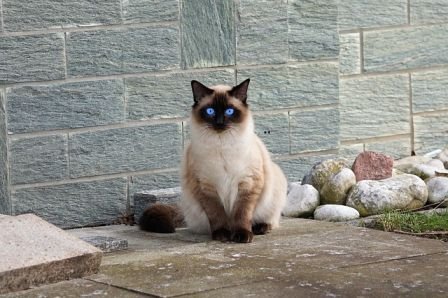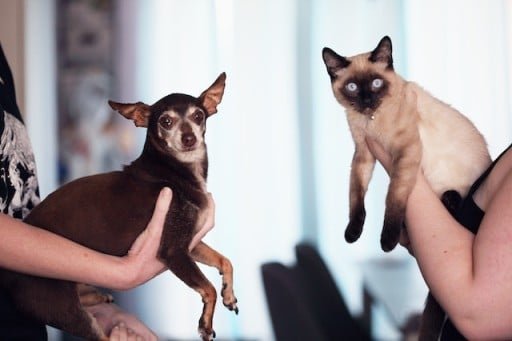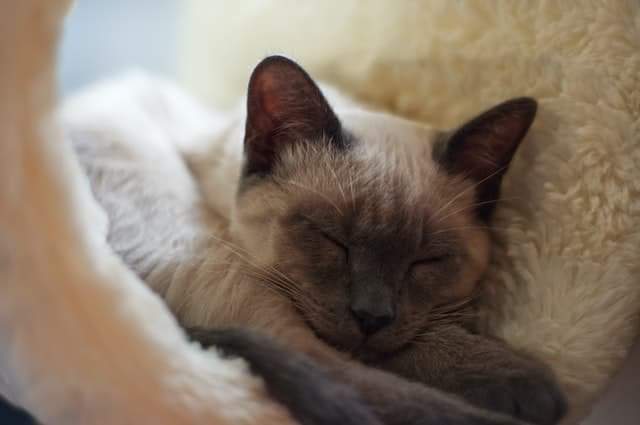A few weeks ago, I attended a small cat show in my hometown, and that was the first time that I saw some cat breeds in person. Among them were Turkish Angora, Ragdoll, and Siamese cats. While these cats sure look great in photographs and videos, they look even better in person.
Since I know how popular these cats are, especially the Siamese breed, I decided to learn more about them. In particular, siamese cats captured my attention because they have a rich history. Additionally, these cats are so often referenced and portrayed in pop culture, so I think it’s time to write an article about them. Stay tuned!
Siamese Cat Characteristics
Appearance
| Fur color | Blue, chocolate, seal, and lilac. |
| Fur pattern | Colorpoint |
| Fur length | Short |
| Eye color & shape | Large, almond-shaped, and slanted eyes that are a vivid blue. |
| Length | Males 12”-14” Females 10”-12” |
| Weight | Males 8-12 lbs Females 6-10 lbs |
| Expected lifespan | 11-15 years |
Personality
| Temperament | Friendly, affectionate, outgoing, devoted, clingy, intelligent, curious, and playful. |
| Kids and other pets | Moderately friendly towards children and other pets, depending on the situation. |
| Sociable and cuddly | They can be shy and aloof when around strangers. When they get to know someone, they become the complete opposite. |
Requirements & Traits
| Feeding | Meat-based food rich in animal protein. Combination of wet and dry food is recommended. Kittens should eat more frequently than adults, 3-4 times a day as opposed to 2-3 times a day. |
| Grooming | Weekly fur brushing, biweekly nail trimming, and regular dental hygiene. |
| Shedding | Low |
| Hypoallergenic | No |
History and Origins

Siamese cats have a long and fascinating history, dating back to ancient Siam (modern Thailand). Modern-age Siamese cats originate from Wichien Maat cats, which were mentioned in the ancient Tamra Maew (The Cat-Book Poems) manuscript.
These cats were considered sacred animals and were often gifted to royalty and various aristocrats as a symbol of good luck. Their name meant “diamond gold,” probably because of their unusual furs. They were also considered rare as gold, and anyone who had them would attract wealth and fortune.
Siamese cats arrived in Europe and the United States in the late 1800s. They quickly became extremely popular among the upper classes. As such, they were a status symbol, and even Queen Victoria had one Siamese cat. And as it usually happens, things that are reserved for higher classes eventually become accessible and popular among the general population.
This also happened with Siamese cats, and in the 20th century, they became popular among ordinary cat lovers in North America and Europe. Their distinct appearance and playful personalities made them a favorite among cat owners. Today, Siamese cats are one of the most popular breeds in the world and can be found in households all over the globe.
Traditional vs. Modern Siamese Type
When researching old cat breeds, I noticed many of them have one thing in common. Usually, there are two “branches” of those breeds. The first branch is the traditional one, which includes cats with the same physical attributes as their ancestors.
The second branch is the modern one, and it includes cats that are the product of relatively recent selective breeding. These breeding initiatives usually favor some physical attributes and try to enhance them, significantly changing the breed’s appearance.
We could see the example of this practice with Persian and Balinese cats, and it is also happening with Siamese cats. Starting in the 1950s, cat show judges and breeders started to favor more slender physical attributes in Siamese cats.
As a result, in the last few decades, modern-type Siamese cats have been fine-boned, narrow-headed, and increasingly long. These cats completely pushed out traditional-type Siamese cats from the cat shows.
However, some breeders, especially those in the UK, still favor traditional-type Siamese cats and continue to breed them in a way that keeps their standard appearance. With few or no recent ancestors in common, traditional and modern Siamese cats are now considered two distinct subbreeds.
Siamese vs. Thai Cats
Apart from distinguishing between modern and traditional Siamese cats, there are also Old-style Siamese cats, today known as Thai cats. At first, they were recognized as a subbreed of Siamese cats but were later recognized as a separate breed.
Thai cats are basically Wichien Maat cats, coming straight from Thailand. In contrast, both traditional and modern Siamese cats are descendants of Wichien Maat cats that arrived in Europe and the USA in the 1800s. Thai cats are also called “Classic Siamese” and even “Applehead” due to their more rounded features when compared to true Siamese cats.
Siamese Cat Personality
Siamese cats are playful, outgoing, and friendly. They are considered one of the most sociable animals, as they require lots of interaction with their owners. They are also known to be highly intelligent, curious, and even mischievous.
Meezers, which is an endearing nickname for Siamese cats, are also extremely vocal. If you expect your cat to be quiet and reserved, you will be very surprised the first time you interact with a Siamese cat. They make a distinctive “meow,” often described as sounding like a child’s voice. Siamese cats love to have “conversations” with their human friends. Even if you think they are just randomly meowing, they are actually trying to talk to you!
If you want an affectionate cat that will enjoy being always somewhere near you, then the Siamese cat breed is perfect for you! These cats are inseparable from their owners, and sometimes, they can get a bit clingy. However, that’s part of their charm!
As clingy as they are, Siamese cats shouldn’t be left alone, as they crave attention and affection 24/7. If left alone for prolonged periods of time and frequently, they can become depressed and destructive.
Maybe you wonder whether a Siamese cat would be friendly toward your child. The answer is positive if your child is 7-8 years old or older and if it knows how to handle cats properly. But if your child is still little or isn’t accustomed to playing with cats, you should wait a bit before getting a Siamese.
Siamese Cat Appearance

Siamese cats are well known for their color point furs and deep blue eyes, but their overall appearance is just as interesting. Of course, the cat’s appearance shouldn’t be the most important criterium in choosing the perfect pet for you, but there is nothing wrong in preferring some breeds over others due to their looks.
Fur
Siamese cats have short, shiny, silky, smooth, and lying close to the body. As such, the Siamese cat’s fur is responsible for this breed’s glossy, elegant, and sleek appearance.
Siamese cat’s fur is always the color point, and it can come in four different combinations. These combinations are seal, lilac, blue, and chocolate point. The most common is the seal point, which refers to beige or light cream fur on the body, while the facial fur is dark brown.
With a lilac point fur pattern, a cat has a white or pale cream/beige body with a pinkish-gray face. Blue point fur pattern is characterized by a white or pale blue-gray body and a darker blue-gray face. Finally, chocolate point cats have light-beige bodies and dark brown faces.
Eyes
Another distinct feature of Siamese cats is their eye color. Their eyes are always vivid blue, which is even more enhanced by the dark fur around the eyes. Also, the Siamese cat’s eyes are large, almond-shaped, slightly slanted, and widely set apart.
Certainly, such eyes contribute a lot to this breed’s striking appearance. Occasionally, their eyes might be a little crossed, but that doesn’t make them any less beautiful.
Size
This is a medium-sized breed with a slender and elegant body type. As with other cat breeds, males are larger than females. A male Siamese cat typically weighs 8-12 lbs, while a female usually weighs 6-10 lbs. When it comes to body length, male Siamese cats are 12-14 inches long on average, while females are typically 10-12 inches long.
Other Body Characteristics
Even though they look quite slender, Siamese cats have firm and strong muscles. The body is tubular, the abdomen is tight, and the shoulders are wider than the hips. such proportions give a slender, graceful, and svelte appearance to these cats.
Just like the rest of the body, the legs are long, elegant, and slim. Hind legs are longer than the front legs. The paws are oval, small, and dainty. Front paws have five toes, while hind paws have four toes.
Often compared to an inverted triangle, Siamese cats’ heads are narrow, long, and wedge-shaped. The cheekbones are pronounced, the chin is strong, and the muzzle is narrow and pointed. As expected, the neck is long and elegant.
These facial features are even more extreme among modern Siamese cats. While the traditional Siamese cats have narrow and slender features, it is even more pronounced in the modern Siamese type.
Daily Life With Siamese Cat

Having a Siamese cat can be such a great experience, but you need to know more about their daily needs. This way, you will become a better owner, and your cat will be happy, well-behaved, and healthy. Keep reading to learn more!
Feeding
Just like other cat breeds, Siamese cats should eat meat-based foods rich in protein and with moderate amounts of fat. A balanced diet will help your Siamese cat live a long and healthy life. That’s why you should always choose commercial cat food of the highest quality.
Make sure to offer your Siamese cat both wet and dry cat food. Wet food is good for keeping your cat hydrated, while dry food is richer in calories and it is good for your cat’s teeth. In most cases, cats prefer wet food, but try to feed your cat with both types of food.
Additionally, you can feed your Siamese cat raw meat, but only if you are certain that it is fresh and free of pathogens. If you don’t want to risk it, you can cook this meat and then give it to your cat, but don’t season it because salt and other spices aren’t so healthy for your cat.
Siamese cats have a reputation for being picky eaters, and if your Siamese cat is like that, you might want to try several different cat food brands and meats until you find what your cat likes the most.
Finally, don’t forget to give your Siamese cat enough fresh water to drink. Cats don’t drink much water on average, especially if they eat a lot of wet food, but they still need to stay hydrated to stay healthy.
Grooming
Short and smooth furs like those in Siamese cats are great for cat owners that don’t want to spend too much time grooming their cats. However, that doesn’t mean that you don’t have to groom your Siamese cat at all.
You still need to brush its fur once a week to keep it shiny, clean, and healthy. Siamese cats don’t shed a lot, and you will reduce their shedding even more with regular fur brushing. Use a soft-bristled brush, as this brush type is perfect for Siamese cats’ fur. You can also bathe your Siamese cat occasionally, but you don’t have to do it more frequently than every few months.
Nail trimming is also important, especially if you have sensitive furniture that your Siamese cat might damage by scratching. To prevent that from happening, trim your cat’s nails every two weeks or at least once a month.
Don’t forget about dental hygiene, either. Regular teeth brushing will prevent various dental diseases. There are specialized cat toothbrushes and toothpaste, and finding them in well-equipped pet stores shouldn’t be such a problem.
The biggest challenge will be to train your cat to put up with the whole process of teeth brushing. If you get your Siamese cat while it is still a kitten, that’s a perfect opportunity to make teeth brushing its habit. Later, as the cat grows up, it is almost impossible to get it used to teeth cleaning.
Alternatively, you can provide your cat with teeth-cleaning snacks. These snacks usually look like regular dry food, but they are more crispy and help clean your cat’s teeth.
Activity
Siamese cats are playful, energetic, and curious animals that require a decent amount of activity to stay physically and mentally stimulated. Don’t worry; they aren’t hyperactive or anything like that; they just require exercise just like most other breeds.
To provide your Siamese cat with enough playtime and activity, buy some cat toys, scratching tree(s), and a climbing tree. Additionally, try to dedicate at least several minutes of your time each day to playing with your cat.
Finally, you can also leash-train your Siamese cat and take it for a walk every now and then. Toys, playtime, and walks will certainly keep your Meezer busy and happy!
If for some reason, you can’t play with your cat as much as both of you would like to, you should consider getting a second cat. Siamese cats can be a bit reserved towards other pets, but if you socialize and introduce them gradually, they should get along really well.
You can even tackle this issue in advance by buying two Siamese kittens from the same litter. This way, you will make sure they bond and get along. But be aware: having two Siamese kittens means a lot of mischief!
Most Common Siamese Cat Health Issues

In general, Siamese cats are considered healthy, but just like with any other cat breed, you can expect some health issues. After all, it’s a part of life. However, with proper diet and care, you can make sure your Siamese cat lives a long and healthy life. That’s why you should be aware of some common diseases that can affect your Siamese cat so that you can provide the necessary help.
Amyloidosis
This condition is characterized by an excess buildup of amyloid proteins in the organs and tissues of the affected cat. This buildup can cause numerous health issues for your cat, including anemia, enlarged liver, enlarged spleen, swollen legs, etc.
There are actually several different types of amyloidosis, but the most common is secondary amyloidosis. This type is caused by an infection and inflammation. Its symptoms are vomiting, diarrhea, weight loss, lethargy, loss of appetite, swollen abdomen and/or legs, etc.
Needless to say, if you notice any of these signs, you should take your cat to the vet. Your vet will be able to determine the right type of therapy, which usually includes anti-inflammatory drugs and antibiotics, as well as symptom management. The sooner you seek help, the better chances of recovery your cat will have.
Progressive Retinal Atrophy
This is actually a group of diseases that target the retina, a part of the eye that’s responsible for sending visual signals to the brain after sensing the light. With progressive retinal atrophy, retina cells deteriorate and perish, which leads to gradual vision loss and even blindness.
Blue-eyed cats, including the Siamese cat breed, are more prone to developing this condition because the gene that causes blue eye color is also linked to the gene responsible for progressive retinal atrophy. Of course, that doesn’t mean that every blue-eyed cat will suffer from vision loss, but they are at a higher risk.
If you notice your cat is having trouble seeing in the dark, losing its peripheral vision, and its pupils are becoming clouded, it might be a sign of progressive retinal atrophy. Sadly, there is no treatment for this condition, but you should still take your cat to the vet.
However, the vet will be able to help you manage your cat’s symptoms, and with their tips in your mind, you will be able to help your cat live the best possible life.
Dental Issues
This is where proper dental hygiene comes in handy and can make a huge difference. Cats can suffer from various dental issues, including gingivitis, periodontal disease, and feline dental resorptive lesions. All these conditions will cause severe discomfort to your cat, and they can even lead to tooth loss.
If you notice your cat has bad breath, has trouble chewing food, or its gums are red and swollen, be assured that it isn’t normal. If you notice these symptoms or any other changes in your cat’s mouth, take it to the vet.
Your vet will be able to prevent further damage from happening and even neutralize the previous damage, depending on the nature of the condition. They will also be able to give you advice on preventing future dental issues through proper dental hygiene.
Obesity
We usually hear about obesity in humans, but it can also affect our pets, including Siamese cats. Nowadays, both humans and their pets have so much food to choose from, while there is a sharp decrease in physical activity.
This leads to obesity as the body can’t spend all the calories it receives through food. As a result, obesity reduces mobility and causes cardiovascular issues, diabetes, joint problems, and even respiratory issues. Since Siamese cats are naturally slender, you should easily notice any excess weight.
Still, if you are not sure if your Meezer is obese or not, take it to the vet. Your veterinarian will not only be able to determine if your cat is obese, but they will also provide you with useful diet advice. if your cat is indeed obese, the vet will come up with a diet plan that will help your cat lose weight.
Feline Lower Urinary Tract Disease
This is actually quite a broad term that covers various different issues that affect the feline urinary tract. These issues can range from infections to bladder stones and even urethral blockages. Needless to say, urinary issues are a serious thing that can even be fatal for your cat if you don’t act in time.
If you notice your cat having problems urinating, or urinating too frequently, take it to the vet. Other symptoms include blood in the urine, unusual thirst, meowing while urinating, licking the urinary opening too frequently, etc.
The vet will determine the cause of these symptoms and will prescribe appropriate therapy.
Siamese Cat Name Suggestions
Once you get yourself a Siamese cat, it is time to name it. You can choose some traditional names that evoke their exotic origins, or you can choose some more basic names. Whichever you choose, it is important that you like it and that it somewhat fits your cat. Here are some of my top picks for Siamese cat names, but you are free to do more research until you find a perfect name.
- Frankie
- Yam
- Milo
- Diamond
- Goldie
- Kimchi
- Oliver
- Pearl
- Aurora
- Millie
- Coco
- Baozi
Buying or Adopting Siamese Cat
Siamese cats are fairly common and you can find one in a shelter with enough patience. Usually, the adoption fee for Siamese cats ranges between $75 and $150, but it can be even higher depending on the individual shelter’s policies.
Adopting a cat from the shelter is a great way to save it from a bleak and often tragic life. However, most Siamese cats in the shelters are adults, so you probably won’t be able to find a kitten if that’s what you want. Additionally, with cats from shelters, you can’t really choose as much as you could if you bought them from a breeder. Finally, these cats can come with underlying medical issues, so keep that in mind when deciding to adopt.
If you want to choose the gender and physical characteristics of your cat, while also being able to get it while it is still a kitten and easy to train, you should research local Siamese cat breeders. It is important that you find a reputable breeder with ethical breeding practices because there are so many unethical breeders out there.
Buying a Siamese cat directly from a breeder can cost you anywhere between $500 and $1500, but the price may be even higher for show-quality Meezers. Also, some breeders are extremely reputable and in demand, so their litters usually cost more than on average.
Frequently Asked Questions
Their unique appearance sets Siamese cats apart from other cat breeds. After all, how can you not notice those vivid blue eyes and interesting fur patterns?
Yes, since they are very social and affectionate, Siamese cats usually enjoy being held and cuddled, given that you hold them properly.
Siamese cats are extremely vocal and will meow a lot to communicate with their owners.
In general, Siamese cats are prone to mischief, especially if they are lonely, bored, or don’t receive enough attention. That’s when they can become destructive.
It depends, usually between 12 and 19 months.
Fun Facts about the Siamese
- Siamese cats have a strong prey drive, and they can be trained to hunt rodents and other small animals. They can also b trained to recognize and find certain scents.
- While they might be susceptible to some health conditions, this breed’s unique immune system makes them less prone to some other conditions, such as feline leukemia.
- Since they originated in Thailand, where the climate is hot and humid, Siamese cats are tolerant to high heat more than other cat breeds.
Siamese Cats In Pop Culture
Siamese cats are so popular that they are often mentioned and portrayed in various works of art and pop culture. Here are only some notable examples:
- In the Disney animated movie “Lady and the Tramp,” two Siamese cats, Si and Am, are mischievous cat sisters looking to cause trouble whenever they can.
- They were also portrayed in several other cartoons, such as “Garfield” and “Tom and Jerry.”
- In the movie “Heartbeets” two robots fall in love, and they adopt a Siamese cat.
- In the movie “The Cat in The Hat,” the main character is a Siamese cat that keeps causing mischief and trouble.
- Siamese cats also found their way into the horror movie genre, particularly in the movie “The Omen” from 1976 and several other less-known movies.
Siamese Cat Alternatives
Do you want a cat similar to Siamese cats, but you don’t want or can’t get a Siamese? Well, you have several options to choose from. For example, you can get Balinese or Javanese cats, which are basically long-haired versions of Siamese cats. These two breeds have the same body shape and size and the same personality as the Siamese cats.
Snowshoe is another cat breed that looks similar to Siamese cats, but it has white “boots.” Tonkinese cat breed is a cross between Siamese and Burmese cats, so they have some similarities to Meezers. Finally, you should consider getting some other breeds, such as Birman, Himalayan, Ragdoll, Exotic Shorthair, Cornish Rex… The list goes on!
Summary
If you are enchanted by the elegance and grace of Siamese cats and their mischief entertains you, you should consider getting one (or two) of these cats. They will be loyal companions that you will be able to train and even teach several tricks.
Above all, Siamese cats are loving, affectionate, gentle, sweet, and intelligent animals that will bring joy to your household. People in the past believed Siamese cats brought fortune and good luck, and there is at least a grain of truth in that. So, what are you waiting for? Bring good luck into your home by getting yourself a lovely Meezer!
